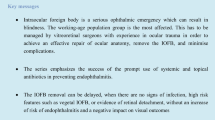Abstract
Purpose
To identify the prognostic factors concerning the anatomy and visual acuity of eyes subject to trauma related posterior intraocular foreign body.
Patients and methods
The records of 28 eyes of 27 patients who underwent pars plana vitrectomy and intraocular foreign body removal during a 5 year period were retrospectively reviewed. Ocular trauma score was calculated for each eye.
Results
The most common initial findings were corneal wound (68%), lens injury (50%), retinal lesion (50%), vitreous hemorrhage (25%), and endophthalmitis (14%). Multiple foreign body causing perforating injury with retained posterior segment foreign body occurred in 7% of the cases. The foreign body was found on the surface of the retina in 39% of the cases. Postoperative complications were retinal detachment (46%), proliferative vitreoretinopathy (25%), and phthysis (4%). No eye was enucleated and 1 eye (4%) lost light perception. The final best corrected visual acuity became better or equal to 0.5 Snellen E in 34% of the eyes. The mean follow-up was 19 months (1.5–60 months).
Conclusions
Prognosis was significantly worse in cases with lower trauma score, initial visual acuity less than 0.1 Snellen E, large foreign body, upset of bacterial endophthalmitis, and with proliferative vitreo-retinopathy. Visual outcomes in our cases were better than estimated follow-up visual acuity based on ocular trauma score parameters.
Similar content being viewed by others
References
Kuhn F, Morris R, Mester V, Witherspoon CD, Mann L, Maisiak R (2002) Epidemiology and socioeconomics. Ophthalmol Clin North Am 15:145–151
Kuhn F, Mester V, Berta A, Morris R (1998) Epidemiology of severe eye injuries. United States Eye Injury Registry (USEIR) and Hungarian Eye Injury Registry (HEIR). Ophthalmologe 95:332–343
Williams DF, Mieler WF, Abrams GW, Lewis H (1988) Results and prognostic factors in penetrating ocular injuries with retained intraocular foreign bodies. Ophthalmology 95:911–916
Hildebrand H (1996) Sixty-six magnet operations with successful extraction of particles of iron from the inferior of the eye in fifty-three cases. Arch Ophthalmol 114:762–763
Kazokoglu H, Saatci O (1990) Intraocular foreign bodies: results of 27 cases. Ann Ophthalmol 22:373–376
Mester V, Kuhn F (1998) Ferrous intraocular foreign bodies retained in the posterior segment: management options and results. Int Ophthalmol 22:355–362
Mieler WF, Ellis MK, Williams DF, Han DP (1990) Retained intraocular foreign bodies and endophthalmitis. Ophthalmology 97:1532–1538
Kuhn F, Maisiak R, Mann L, Mester V, Morris R, Witherspoon CD (2002) The Ocular Trauma Score (OTS). Ophthalmol Clin North Am 15:163–165
Kuhn F, Morris R, Witherspoon CD, Heimann K, Jeffers JB, Treister G (1996) A standardized classification of ocular trauma. Graefes Arch Clin Exp Ophthalmol 234:399–403
Pavlovic S, Schmidt KG, Tomic Z, Dzinic M (1998) Management of intra-ocular foreign bodies impacting or embedded in the retina. Aust N Z J Ophthalmol 26:241–246
Schmidt JG, Mansfeld-Nies R, Nies C (1987) On the recovery of the electroretinogram after removal of intravitreal copper particles. Doc Ophthalmol 65:135–142
Tawara A (1986) Transformation and cytotoxicity of iron in siderosis bulbi. Invest Ophthalmol Vis Sci 27:226–236
Micovic V, Milenkovic S, Opric M (1990) Acute aseptic panophthalmitis caused by a copper foreign body. Fortschr Ophthalmol 87:362–363
Duke-Elder S (1972) System of ophthalmology. Henry Kimpton, London, pp 451–649
Kuhn F (2002) Intraocular foreign bodies. In: Pieramici DJ (ed) Ocular trauma: principles and practice. Thieme, New York Stuttgart, pp 235–263
Author information
Authors and Affiliations
Corresponding author
Additional information
None of the authors has a financial or proprietary interest in any material or method mentioned in the article.
Rights and permissions
About this article
Cite this article
Szijártó, Z., Gaál, V., Kovács, B. et al. Prognosis of penetrating eye injuries with posterior segment intraocular foreign body. Graefes Arch Clin Exp Ophthalmol 246, 161–165 (2008). https://doi.org/10.1007/s00417-007-0650-1
Received:
Revised:
Accepted:
Published:
Issue Date:
DOI: https://doi.org/10.1007/s00417-007-0650-1




